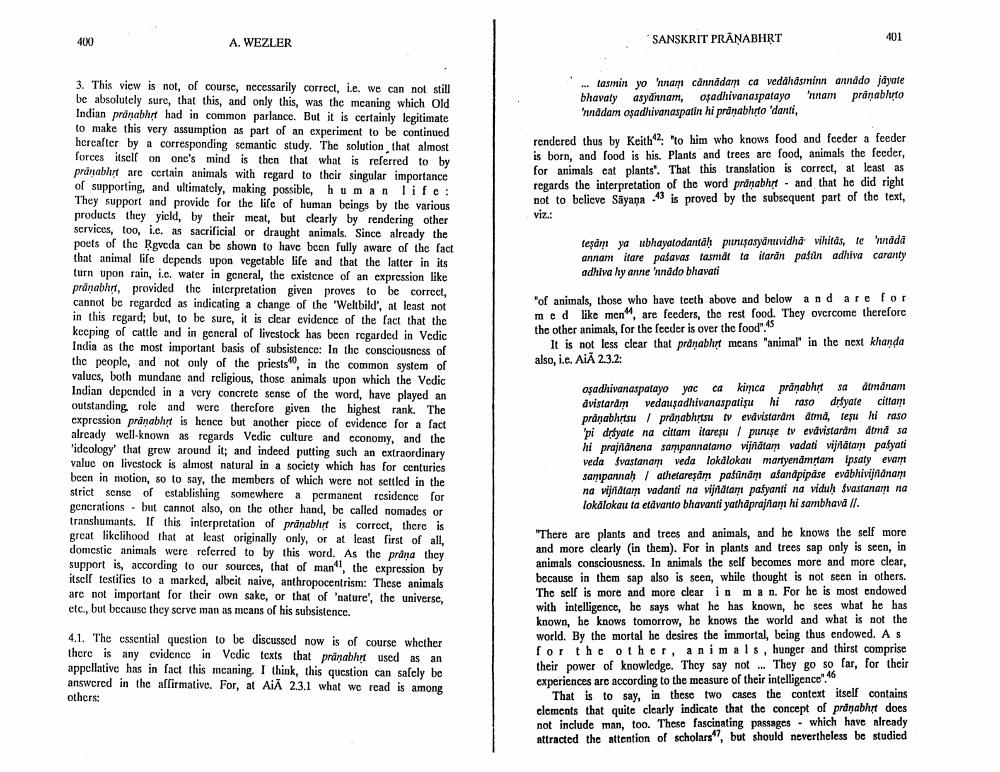Book Title: Sanskrit Pranabhrt Or What Supports what Author(s): A Wezler Publisher: A Wezler View full book textPage 5
________________ 400 A. WEZLER 3. This view is not, of course, necessarily correct, i.e. we can not still be absolutely sure, that this, and only this, was the meaning which Old Indian pranabhṛt had in common parlance. But it is certainly legitimate to make this very assumption as part of an experiment to be continued hereafter by a corresponding semantic study. The solution, that almost forces itself on one's mind is then that what is referred to by pranabhrt are certain animals with regard to their singular importance of supporting, and ultimately, making possible, human life: They support and provide for the life of human beings by the various products they yield, by their meat, but clearly by rendering other services, too, i.e. as sacrificial or draught animals. Since already the poets of the Ṛgveda can be shown to have been fully aware of the fact that animal life depends upon vegetable life and that the latter in its turn upon rain, i.c. water in general, the existence of an expression like pranabhrt, provided the interpretation given proves to be correct, cannot be regarded as indicating a change of the 'Weltbild', at least not in this regard; but, to be sure, it is clear evidence of the fact that the keeping of cattle and in general of livestock has been regarded in Vedic India as the most important basis of subsistence: In the consciousness of the people, and not only of the priests, in the common system of values, both mundane and religious, those animals upon which the Vedic Indian depended in a very concrete sense of the word, have played an outstanding role and were therefore given the highest rank. The expression prāṇabht is hence but another piece of evidence for a fact already well-known as regards Vedic culture and economy, and the 'ideology' that grew around it; and indeed putting such an extraordinary value on livestock is almost natural in a society which has for centuries been in motion, so to say, the members of which were not settled in the strict sense of establishing somewhere a permanent residence for generations but cannot also, on the other hand, be called nomades or transhumants. If this interpretation of pränabht is correct, there is great likelihood that at least originally only, or at least first of all, domestic animals were referred to by this word. As the prana they support is, according to our sources, that of man, the expression by itself testifies to a marked, albeit naive, anthropocentrism: These animals are not important for their own sake, or that of 'nature', the universe, etc., but because they serve man as means of his subsistence. 4.1. The essential question to be discussed now is of course whether there is any evidence in Vedic texts that pranabhṛt used as an appellative has in fact this meaning. I think, this question can safely be answered in the affirmative. For, at AiA 2.3.1 what we read is among others: SANSKRIT PRANABHRT 401 tasmin yo 'nnam cännädam ca vedähäsminn annddo jayate bhavaty asyannam, osadhivanaspatayo 'nnam praṇabluto 'nnddam osadhivanaspatin hi pranabhṛto 'danti, rendered thus by Keith42: "to him who knows food and feeder a feeder. is born, and food is his. Plants and trees are food, animals the feeder, for animals cat plants". That this translation is correct, at least as regards the interpretation of the word pranabhṛt and that he did right not to believe Sayana 43 is proved by the subsequent part of the text, viz.: teşam ya ubhayatodantaḥ puruşasyänuvidha vihitas, te 'nnädä annam itare pasavas tasmät ta itaran pasan adhiva caranty adhiva hy anne 'nnado bhavati "of animals, those who have teeth above and below and are for med like men, are feeders, the rest food. They overcome therefore the other animals, for the feeder is over the food":45 It is not less clear that pranabht means "animal" in the next khanda also, i.e. AiA 2.3.2: ātmānam raso oşadhivanaspatayo yac ca kimca prānabhṛt sa ävistaram vedauşadhivanaspatişu hi driyate cittam pranabhṛtsu präṇabhṛtsu tv evavistaram atma, teşu hi raso 'pi dryate na cittam itareşu puruşe tv evävistaram ātmā sa hi prajñanena sampannatamo vijñātam vadati vijñātam palyati veda Svastanam veda lokālokau martyenāmṛtam ipsaty evam sampannah athetareṣām pašinām atanapipase evabhivijñānam na vijñātam vadanti na vijñātam pafyanti na viduḥ Svastanam na lokālokau ta etavanto bhavanti yathaprajñam hi sambhava II. "There are plants and trees and animals, and he knows the self more and more clearly (in them). For in plants and trees sap only is seen, in animals consciousness. In animals the self becomes more and more clear, because in them sap also is seen, while thought is not seen in others. The self is more and more clear in ma n. For he is most endowed with intelligence, he says what he has known, he sees what he has known, he knows tomorrow, he knows the world and what is not the world. By the mortal he desires the immortal, being thus endowed. A s for the other, animals, hunger and thirst comprise their power of knowledge. They say not. They go so far, for their experiences are according to the measure of their intelligence".46 That is to say, in these two cases the context itself contains elements that quite clearly indicate that the concept of pranabhṛt does not include man, too. These fascinating passages which have already attracted the attention of scholars, but should nevertheless be studiedPage Navigation
1 ... 3 4 5 6 7 8 9 10 11
